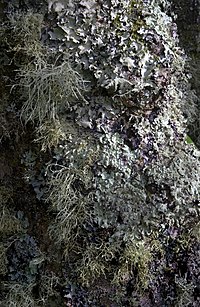
Photo from wikipedia
Lichens occur in most terrestrial ecosystems; they are often present as minor contributors, but in some forests, drylands and tundras they can make up most of the ground layer biomass.… Click to show full abstract
Lichens occur in most terrestrial ecosystems; they are often present as minor contributors, but in some forests, drylands and tundras they can make up most of the ground layer biomass. As such, lichens dominate approximately 8% of the Earth's land surface. Despite their potential importance in driving ecosystem biogeochemistry, the influence of lichens on community processes and ecosystem functioning have attracted relatively little attention. Here, we review the role of lichens in terrestrial ecosystems and draw attention to the important, but often overlooked role of lichens as determinants of ecological processes. We start by assessing characteristics that vary among lichens and that may be important in determining their ecological role; these include their growth form, the types of photobionts that they contain, their key functional traits, their water‐holding capacity, their colour, and the levels of secondary compounds in their thalli. We then assess how these differences among lichens influence their impacts on ecosystem and community processes. As such, we consider the consequences of these differences for determining the impacts of lichens on ecosystem nutrient inputs and fluxes, on the loss of mass and nutrients during lichen thallus decomposition, and on the role of lichenivorous invertebrates in moderating decomposition. We then consider how differences among lichens impact on their interactions with consumer organisms that utilize lichen thalli, and that range in size from microfauna (for which the primary role of lichens is habitat provision) to large mammals (for which lichens are primarily a food source). We then address how differences among lichens impact on plants, through for example increasing nutrient inputs and availability during primary succession, and serving as a filter for plant seedling establishment. Finally we identify areas in need of further work for better understanding the role of lichens in terrestrial ecosystems. These include understanding how the high intraspecific trait variation that characterizes many lichens impacts on community assembly processes and ecosystem functioning, how multiple species mixtures of lichens affect the key community‐ and ecosystem‐level processes that they drive, the extent to which lichens in early succession influence vascular plant succession and ecosystem development in the longer term, and how global change drivers may impact on ecosystem functioning through altering the functional composition of lichen communities.
Journal Title: Biological Reviews
Year Published: 2017
Link to full text (if available)
Share on Social Media: Sign Up to like & get
recommendations!